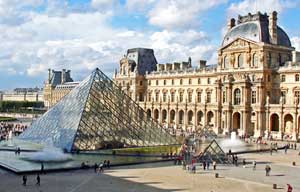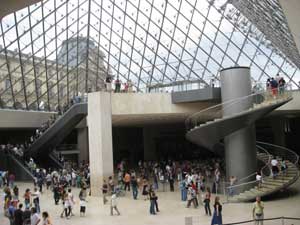Le Musée du Louvre deserves lots and lots of superlatives: the world’s largest museum is also its most visited museum, and, some would say, the greatest museum. It almost goes without saying that (at least!) one trip to the Louvre during a visit to Paris is a necessity.
First constructed as a fortress in the Middle Ages, the Louvre had to be rebuilt in the mid-16th century and was converted into a a royal palace. In 1793 in the midst of the Revolution the Louvre became a museum.
Today, it is unsurpassed in terms of its collection of Western art from the Middle Ages to about 1848 (see the Musée d’Orsay just over the river for later collections).

A succession of kings Henry IV, Louis XIII and Louis XV and, when the French had grown tired of kings, emperors Napoléon I and Napoléon III all contributed to its construction.
During World War II the museums curators managed to hide the most precious artworks as the rest were looted by the Nazis. Thankfully most of the stolen pieces were recovered after the war but it wasn't until François Mitterrand that the Louvre saw any more change.
When he was elected president in 1981, Mitterand embarked upon his quest to modernize Paris and the Louvre was part of that plan.
The ‘Grand Louvre’ project pioneered by President Mitterand in 1989 doubled the museum’s exhibition space and today it contains some 35,000 objets d’art. This means, as you might imagine, that a visit to the Louvre can seem intimidating to most visitors.
While not wanting to turn a relaxing trip into a military operation, it is important to have some kind of plan when you visit the Louvre, to avoid feeling overwhelmed and frustrated.

Spanning eight thematic departments and three wings, le Musée du Louvre houses masterpieces by European masters such as Da Vinci or Vermeer, as well as unrivalled Greco-Roman, Egyptian, and Islamic arts collections.
Since it has been estimated that it would take 9 months to see all that the Louvre has to offer, the best strategy, after ticking off the most famous, is to choose a specific department or particular time period and focus on that.
To avoid the big queues, try and get there early and head straight for the Mona Lisa. If not, the Louvre is open late on Wednesday and Friday nights and it is always much quieter then (and the ticket price is reduced).
There are pretty snazzy multimedia guides available for each wing. You have to deposit a driver’s license, passport, or credit card to get them and they are also available to reserve online.
Buying a ticket in advance means that you can avoid the crowds entering through the glass pyramid and enter from rue de Rivoli, or via the Carrousel du Louvre shopping mall instead. Alternatively, enter from the metro station and there are far fewer people.
Finally, don’t forget that le Musée du Louvre is closed on Tuesday.
The Louvre plays a key role in Dan Brown's best selling novel The Da Vinci Code and the 2006 movie based on the book. In the opening pages of the novel, the curator of the Louvre is found murdered, naked and posed like Leonardo da Vinci's Vitruvian Man, in the Grand Gallery of the museum.
When it came to talk of filming some of the movie in certain locations in the Louvre, the museum's new ambitious director, Henri Loyrette jumped on the opportunity. He acquiesced to the producers' inquiries and earned the Louvre a cool $2.5 million.
However while the museum's new director is busy raising millions, his methods are raising hackles in French art circles.
His actions are called scandalous and mercenary by some leaders of the art world and in 2008 a petition of over 500 signatures - including some former top Louvre curators - was collected to oppose his plans.